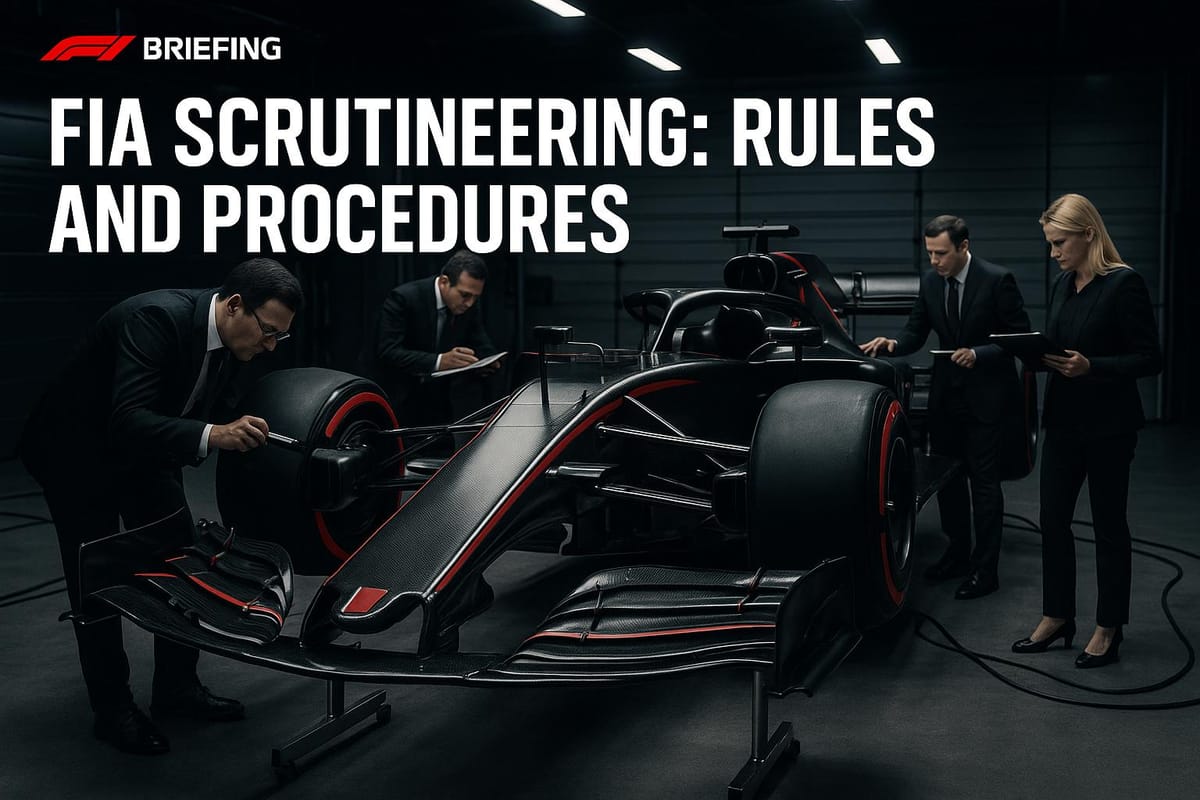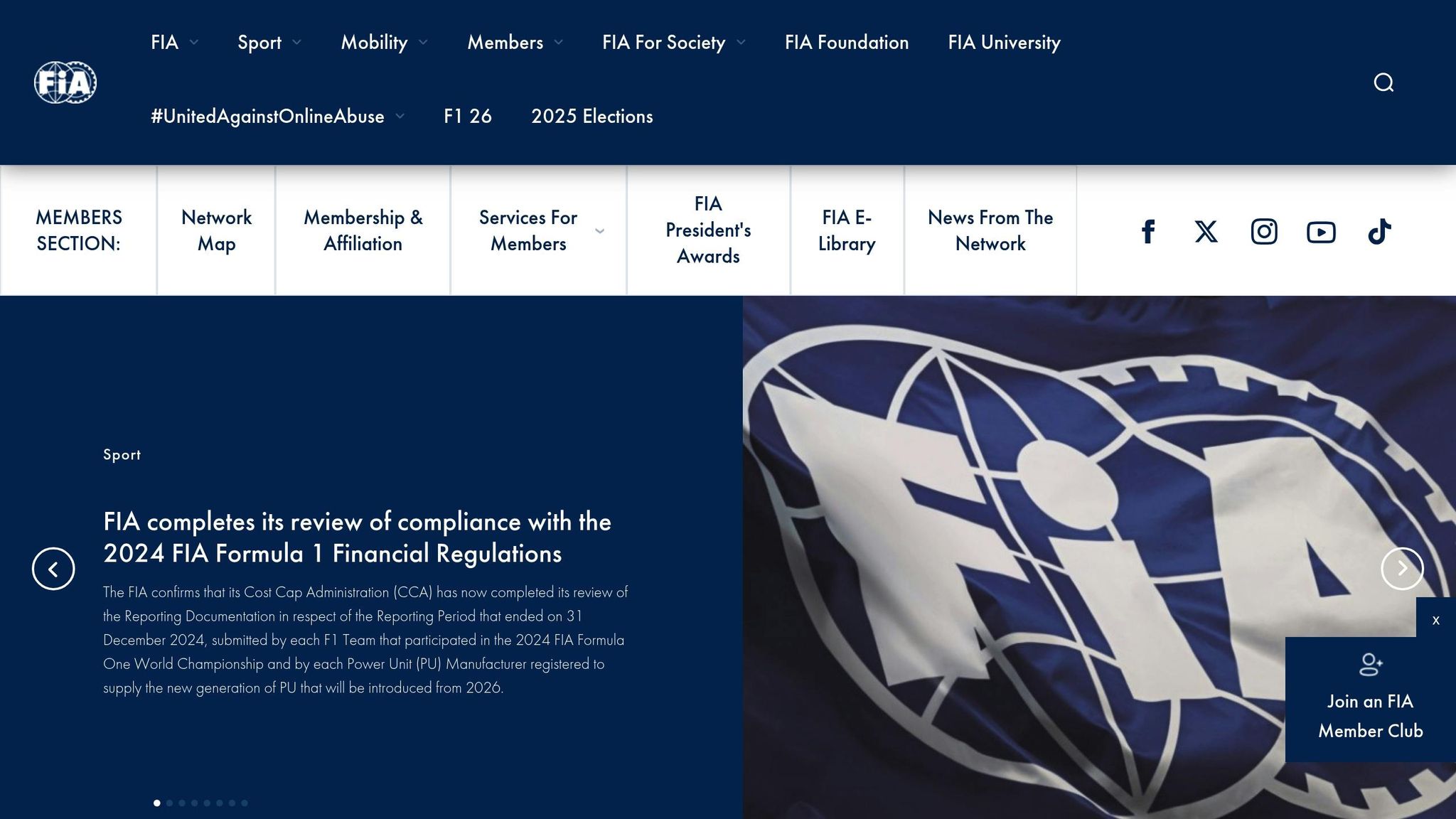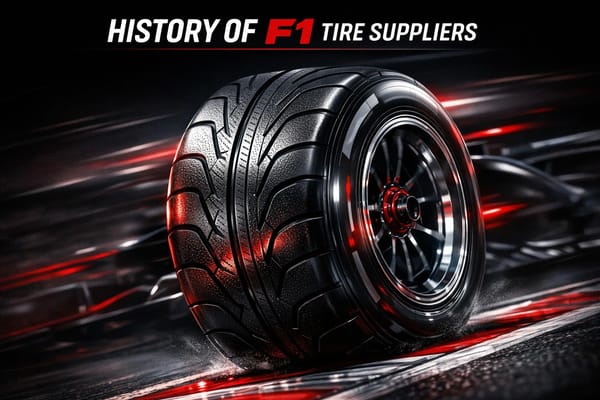FIA Scrutineering: Rules and Procedures
Explore the FIA's rigorous scrutineering process in Formula 1, ensuring compliance with technical and safety regulations throughout race weekends.

FIA scrutineering ensures that Formula 1 cars comply with strict technical and safety regulations. This process involves pre-event, in-race, and post-race inspections, using advanced tools like laser scanning and CAD systems to verify weight, dimensions, aerodynamics, and safety systems. Key checks include:
- Pre-Event: 56 safety checks, compliance forms, and physical inspections before practice.
- In-Race: Random inspections during sessions and re-checks for modified or damaged cars.
- Post-Race: Focus on weight checks, fuel samples, and unusual performance.
Penalties for violations range from fines to disqualifications, as seen in high-profile cases like the 2023 United States Grand Prix. FIA aims to maintain fair competition while evolving scrutineering methods to match F1’s growing complexity.
FIA Insights - Inside the FIA Formula 1 Scrutineering Garage (ft. Tom Clarkson)

3 Phases of FIA Scrutineering
FIA scrutineering is a thorough process divided into three phases - pre-event, in-race, and post-race. Its purpose is to ensure that all cars meet technical and safety regulations from the moment they arrive until the race concludes.
Pre-Event Scrutineering
The first phase kicks off on Thursday (or Wednesday in Monaco) and is a mandatory step before any car can join a session during the race weekend. Teams are required to submit a declaration form to the FIA, confirming their readiness for the weekend, before the physical inspections begin.
Between 10:00 AM and 4:00 PM the day before the first practice session, FIA scrutineers conduct 56 scheduled safety checks, covering both race cars and spare T-cars. These checks range from verifying compliance with weight regulations to ensuring that all essential safety systems are functioning as required.
If a team fails to meet these requirements, the consequences are immediate. Inaccurate forms or missed deadlines can result in penalties, and cars that don’t pass inspection are barred from competing until they are brought into compliance.
Once pre-event checks are completed, attention shifts to real-time monitoring during the race weekend.
In-Race Scrutineering
During practice, qualifying, and the race itself, FIA officials continuously monitor cars and garage activities to ensure ongoing compliance. Random inspections are conducted, and any car that undergoes significant modifications or is involved in an incident must be re-inspected before returning to competition.
Scrutineers have the authority to inspect any car at any time, even requiring complete dismantling if necessary. Additionally, the race director or clerk of the course can order immediate inspections for cars involved in accidents to ensure safety standards remain intact.
This constant supervision serves as a strong deterrent, encouraging teams to maintain compliance throughout every session.
After the race weekend concludes, the focus shifts to post-event checks to confirm adherence to regulations.
Post-Race Scrutineering
The final phase of scrutineering ensures that cars complied with regulations during the race. Post-race inspections are conducted on a selection of cars, often focusing on finishers and vehicles with unusual performance.
One of the most critical aspects of this phase is the weight check. Specialized equipment is used to confirm that cars meet minimum weight requirements, even after accounting for fuel consumption and wear. This phase often uncovers violations missed earlier, such as the disqualifications of Charles Leclerc and Lewis Hamilton at the 2023 United States Grand Prix for excessive skid block wear, or Sebastian Vettel’s removal from the 2021 Hungarian Grand Prix results due to an insufficient fuel sample.
If a car has been dismantled, modified, or involved in an accident, it must undergo re-scrutineering. Teams must submit a written request to the stewards for approval, and these inspections usually take place the following morning to allow for a detailed review.
This final step ensures that race results reflect genuine performance, free from any technical irregularities or unfair advantages.
Technical and Safety Compliance Checks
The FIA's scrutineering process involves detailed inspections of both technical components and safety equipment to ensure every car adheres to Formula 1's strict regulations. These checks rely on advanced technology and rigorous testing to uphold fair competition and protect drivers.
Technical Inspections
Beyond the initial pre-race checks, technical inspections ensure that every car aligns with F1's precise regulations.
Scrutineers examine car weight, dimensions, aerodynamic components, and engine regulations using specialized tools and methods.
- Weight checks: Every car must meet the minimum weight of 798 kg (1,760 lbs) for the 2023 season, including the driver. Dedicated weighing rigs are used to confirm compliance, with checks conducted multiple times during the weekend. Post-race weighing is especially critical, as fuel usage and wear can alter the car's weight.
- Dimensional accuracy: Laser scanning and CAD systems measure key dimensions like length, width, height, and wheelbase. This technology creates precise 3D models, identifying even millimeter-level deviations from approved specifications.
- Aerodynamic inspections: Scrutineers visually examine and perform load tests on components like front and rear wings to ensure they don’t flex beyond permitted limits. Excessive flexibility could provide an unfair aerodynamic boost during high-speed racing.
- Engine and electronics checks: Advanced software analysis is used to inspect engine mapping and electronic systems for any illegal driver aids or performance modifications. For instance, the 2019 Renault disqualification at the Japanese Grand Prix highlighted the thoroughness of these inspections.
- Fuel sampling: Teams must provide exactly 1 liter of fuel post-race for analysis. This sample is tested to confirm its composition and detect any unauthorized additives.
Safety Equipment Checks
While technical inspections focus on performance, safety checks prioritize driver protection by ensuring all equipment meets FIA standards.
- Helmets: Each driver’s helmet must carry valid FIA certification, fit properly, and show no signs of damage. Scrutineers check for homologation stickers and reject helmets with visible wear or expired certifications.
- HANS devices: These critical safety devices are inspected for proper installation and connection to helmets and seat belts. Proper adjustment and integrity are crucial to safeguard drivers during impacts.
- Seat belts: Scrutineers verify the condition and installation of seat belt systems, checking mounting points, certification dates, and webbing quality. Any frayed or damaged components must be replaced immediately.
- Fire extinguishers: These systems must be fully operational, securely mounted, and accessible to both drivers and safety crews. Activation mechanisms are tested, and extinguishing agents are checked to meet FIA standards.
- Survival cells: The cockpit’s protective structure undergoes thorough inspections, especially after incidents. These checks ensure the driver’s primary safety system remains intact throughout the race weekend.
The FIA conducts 56 scheduled safety checks during initial scrutineering, covering both race cars and spare T-cars before any track activity begins. This exhaustive process ensures all safety systems are functioning correctly from the start of the weekend to the final race.
Documentation and Compliance
Every technical and safety check is documented in official FIA reports, with any irregularities immediately flagged for the stewards. This creates a transparent audit trail to maintain accountability throughout the process.
Teams must also provide up-to-date technical documentation and submit accurate declarations of conformity before each event. If significant modifications or repairs occur, the car must be re-inspected, emphasizing the continuous nature of compliance checks during the race weekend.
Penalties and Case Studies
When it comes to Formula 1, failing to meet technical and safety standards is no small matter. Non-compliance during scrutineering can lead to swift and severe penalties, underscoring just how crucial these inspections are. The FIA enforces these regulations with a range of penalties, from financial fines to outright disqualifications, ensuring that teams take compliance seriously.
Types of Penalties
The FIA has a variety of penalties at its disposal for teams that fail scrutineering. For the most serious violations - those that compromise race integrity or driver safety - disqualification is the go-to penalty. This harsh measure strips teams of all points and positions earned during the event.
For less severe breaches, the FIA may opt for points deductions, which allow teams to retain their race results while still facing significant consequences. Fines, on the other hand, are typically reserved for minor procedural errors or technical oversights that don’t provide a competitive edge.
The severity of the penalty hinges on several factors. FIA stewards assess whether the infraction offered an unfair competitive advantage, compromised safety, or stemmed from a simple procedural error. They also consider intent and whether the issue is a repeat offense. Generally, technical violations that directly impact car performance receive harsher treatment compared to administrative mistakes.
In some cases, failing scrutineering can lead to more invasive measures. Teams might be required to dismantle the car entirely for a detailed inspection, provide specific parts or fuel samples for lab analysis, and even cover the costs of the investigation. Before re-entering competition, the car must pass additional checks, and any subsequent modifications require approval from the stewards.
Famous Scrutineering Cases
Over the years, high-profile scrutineering failures have shaped the enforcement landscape of F1, proving how non-compliance can have far-reaching consequences.
Take the 2023 United States Grand Prix, for example. Charles Leclerc (Ferrari) and Lewis Hamilton (Mercedes) both faced disqualification after post-race inspections revealed excessive wear on their rear skid blocks. This decision not only cost them valuable championship points but also ignited debates about the consistency and fairness of post-race checks.
Another memorable case occurred during the 2021 Hungarian Grand Prix, when Sebastian Vettel’s Aston Martin was disqualified despite a stellar second-place finish. The issue? Scrutineers could only extract 0.3 liters of fuel from his car instead of the required 1 liter. Such technical missteps can wipe out hard-fought victories and dramatically shift championship standings.
The 2019 Japanese Grand Prix offered yet another example of the FIA’s vigilance. Both Renault cars were disqualified after inspections uncovered an unauthorized pre-set brake bias system. This violation of electronic system regulations led to the team losing all points from the event, highlighting just how thorough the FIA’s investigations can be.
| Year | Event | Team/Driver(s) | Violation | Penalty |
|---|---|---|---|---|
| 2023 | United States Grand Prix | Charles Leclerc, Lewis Hamilton | Excessive skid block wear | Disqualification |
| 2021 | Hungarian Grand Prix | Sebastian Vettel (Aston Martin) | Insufficient fuel sample | Disqualification |
| 2019 | Japanese Grand Prix | Renault | Illegal driver aids | Disqualification |
These penalties can drastically alter championship outcomes. Losing podium finishes or critical points due to technical failures can shift the balance in tight title races, sometimes deciding the fate of entire championships.
However, these decisions are not without controversy. After the 2023 US Grand Prix disqualifications, questions arose about the selection process for post-race inspections, with some teams arguing that only certain cars were tested for skid block wear. In response, the FIA has begun reviewing its procedures and is considering more randomized or comprehensive inspections to address fairness concerns. These cases not only highlight the current enforcement methods but also fuel ongoing discussions about how scrutineering can evolve to ensure the sport’s integrity.
Evolution and Future of FIA Scrutineering
Formula 1 scrutineering has come a long way, transitioning from simple manual checks to a highly advanced, tech-driven process. This transformation reflects the growing complexity of F1 cars and underscores the FIA's dedication to maintaining fairness and safety in the sport.
Historical Changes in Scrutineering
In the early days of Formula 1, scrutineering was a straightforward affair. Officials relied on visual inspections and basic tools like rulers, scales, and calipers to measure compliance. But as F1 cars became more technically advanced, these methods fell short. The 2000s marked a major turning point, with the FIA introducing digital tools like Computer-Aided Design (CAD) systems. Teams were required to submit electronic documentation of their car designs, allowing scrutineers to compare the physical cars against their digital blueprints with far greater accuracy. This shift significantly reduced the potential for human error.
The introduction of specialized scrutineering rigs further addressed the increasing complexity of modern F1 cars. Today, scrutineering involves cutting-edge technologies such as laser scanning, capable of detecting even millimeter-level variations. The scope of inspections has also expanded to include a wide range of safety equipment, ensuring that every aspect of the car meets strict regulations.
Current Trends and Future Challenges
Despite these advancements, modern scrutineering faces fresh challenges that require creative solutions. F1 teams have access to vast engineering resources, while the FIA operates with a much smaller group of scrutineers. This disparity is particularly evident during post-race inspections. A notable example occurred at the October 2023 United States Grand Prix, where Charles Leclerc and Lewis Hamilton were disqualified due to skid block wear violations. However, only a small selection of cars underwent detailed inspection, raising concerns that other infractions might go unnoticed due to limited time and manpower.
Looking ahead, technologies like artificial intelligence and machine learning could transform the scrutineering process. These tools have the potential to analyze massive amounts of telemetry and technical data far faster than humans can. Similarly, automated inspection systems - using robotics and advanced sensors - might handle certain checks independently, improving both speed and consistency. Such systems could operate continuously throughout race weekends, reducing the likelihood of missed violations.
The FIA is also exploring ways to make scrutineering more transparent and fair. One idea is to randomize the selection of cars for post-race inspections, ensuring every team is equally likely to face scrutiny, regardless of their performance or championship position. However, adopting these advanced technologies comes with its own set of hurdles, including high development costs and the ongoing need for human expertise to interpret complex technical issues.
As Formula 1 continues to push the boundaries of engineering, scrutineering must evolve to keep pace. By learning from recent controversies and embracing emerging technologies, the FIA can uphold its commitment to technical compliance and safety while preserving the competitive spirit that defines Formula 1.
Conclusion
FIA scrutineering plays a critical role in upholding Formula 1's commitment to fairness and driver safety. This thorough, three-phase process - spanning pre-event, in-race, and post-race inspections - ensures that all cars meet strict safety and technical standards, minimizing risks and maintaining a level playing field.
At its core, scrutineering safeguards the integrity of the sport. Cars that fail to comply with regulations face severe penalties, including fines and disqualifications, as seen in several high-profile cases. Modern scrutineering methods go far beyond basic visual checks, incorporating advanced technology to keep pace with Formula 1's ever-evolving technical complexity.
However, challenges persist. The debate over the adequacy and consistency of post-race inspections continues to grow, with resource limitations often cited as a concern. FIA scrutineers frequently contend with tight timeframes and limited personnel, especially when compared to the extensive engineering teams fielded by F1 constructors. The 2023 US Grand Prix controversy, where only a small selection of cars underwent detailed post-race checks, has fueled calls for more transparent and comprehensive procedures.
Looking to the future, scrutineering must adapt to the regulatory shifts set for 2026, ensuring it remains in sync with F1's advancing technology and engineering innovations. For a closer look at these upcoming changes and their implications, F1 Briefing provides expert analysis and behind-the-scenes coverage. As Formula 1 continues to push the limits of engineering, scrutineering remains a vital pillar in preserving the sport's competitive integrity.
FAQs
How does the FIA maintain fairness and consistency during post-race scrutineering despite limited resources and selective inspections?
The FIA maintains a level playing field in post-race scrutineering through strict procedures and cutting-edge technology. These inspections focus on ensuring cars comply with technical and safety regulations, confirming that every vehicle meets the required standards. While not every car undergoes inspection after a race, the selection process is carefully structured to avoid bias and uphold fairness.
To ensure precision, the FIA employs tools like 3D scanning and telemetry analysis to check for compliance with technical rules. A mix of randomized checks and targeted inspections of specific parts ensures no team gains an unfair edge. By combining these methods with transparent reporting, the FIA protects the competitive balance in Formula One.
What new technologies are being explored to improve the FIA scrutineering process for F1 cars?
The FIA is always looking for ways to improve how it inspects F1 cars, especially as these machines become more complex. Some of the technologies under consideration include automated scanning systems and AI-driven analysis tools. These could make technical inspections more precise and efficient, catching even the tiniest irregularities in car designs to ensure everything aligns with the rules.
Another idea being explored is using real-time telemetry data during races to monitor compliance as events unfold. This could cut down on the need for lengthy post-race inspections. These efforts are all about preserving the fairness of the sport while keeping up with its fast-paced technological advancements.
How do scrutineering penalties affect championship standings, and are there notable examples from recent F1 seasons?
Scrutineering penalties can have a major effect on championship standings, often leading to drivers or teams being disqualified from races or having their results adjusted. These penalties typically stem from breaking technical or safety rules, like exceeding weight limits or using parts that don't meet regulations. The fallout can mean losing critical points or even shaking up the team rankings in the Constructors' Championship.
One memorable instance took place during the 2021 F1 season. Lewis Hamilton faced disqualification from qualifying at the Brazilian Grand Prix due to a rear-wing infringement. While he impressively fought back to win the race, the incident underscored how scrutineering violations can shape race results and championship dynamics. It’s a clear reminder of how crucial it is for teams to comply with FIA regulations to ensure fairness and uphold safety standards in the sport.




